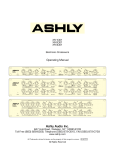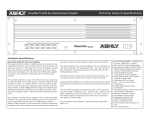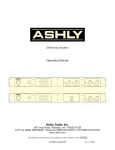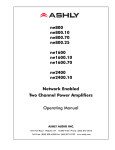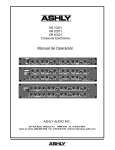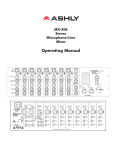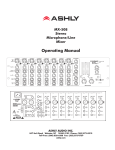Download Ashly SC-44 User's Manual
Transcript
r —"1 100 FERNWOOD AVENUE (716) 544-5191 ROCHESTER, N.Y. 14621 MODEL SC-44 KEYBOARD INPUT PROCESSOR OPERATING INSTRUCTIONS manufacturer of professional audio equipment L "4 ВЕ I. INTRODUCTION The Ashly Audio model SC-44 Keyboard Input Processor was designed to help solve some of the problems associated with today's electronic keyboard instruments. In particular, it provides a means of performing the critical first stage of amplification for a wide variety of musical instruments with an absolute minimum of noise and signal loss, has provision for the connection of studio type line-level effects devices, operates with either line-level power amplifiers or musical instrument amps, and includes a direct output with a separate level control for connection to studio or PA console microphone inputs. Individual tone controls for each channel are low and high shelving type. Master tone control is accomplished using a sophisticated 3-band tunable equalizer making possible a wide range of voicings. A "peak" indicator warns of approaching overload anywhere in the unit and the overload characteristic is one of "clean" clipping free from spikes or transients. II. INPUT, OUTPUT, AND POWER CONNECTIONS The preamp should be connected to a 3-wire grounded outlet supplying 120 Volts, 50-60 Hz. Power consumption is 12 watts. Inputs are high-impedance, unbalanced on a standard 1/4" mono phone jack mating with a standard mono phone plug such as a Switchcraft #280. + Return connectors are all balanced inputs on a standard 1/4" stereo phone jack. on the ring. The high side is on the tip, the low side Unbalanced sources may also be connected to the returns by simply using a mono phone plug. Except for the mic-level PA output, all output connections are unbalanced on standard 1/4" phone jacks which mate with a standard phone plug such as a Switchcraft model 280. The mic-level PA output is a 3-pin male XLR connector and is wired as follows: Pin Pin Pin 1 2 3 Ground Signal Low Signal High IIT. FUNCTIONS OF INPUTS AND OUTPUTS ON INDIVIDUAL CHANNELS A. Input The channel input impedance is 2.2 megohms which will impose virtually no load on any musical instrument, insuring maximum level and high frequency response. Nominal operating level is -20 dBV, but levels from -50 to +10 dBV provide good results. Low or high impedance sources are acceptable. B. EFFECTS SEND-RETURN These two jacks may be used to insert line-level effects or proces- sing devices into the channel signal path. Connect the EFFECT SEND to the device input and connect the device output to the EFFECT RETURN. This patch point is post eq and pre channel fader, (LEVEL) Mic-level (-50) effects devices should be connected between the instrument and the SC-44 channel input rather than in the effects loop. IV. MASTER INPUTS AND OUTPUTS A. MASTER EFFECT SEND-RETURN These two jacks are used to insert effects or processing devices into the entire mix. Hookup is exactly the same as on the channels. The patch is pre eq. and pre output faders. B. AUX LINE LEVEL INPUT This is a line level unbalanced input which can be used to couple the output of another SC-44 or another mixer into the main mix buss of the SC-44. Impedance is 3.3K ohms. C. STAGE OUTPUTS Use the HIGH-level output to directly drive a power amplifier (Crown, BGW, Phase Linear, etc.) and use the LOW-level output to drive conventional musical instrument amps. If you need more or less level and can't correct the problem by adjustment, try the other output. D. PA OUTPUTS Use the mic-level PA output to directly connect the SC-44 to a studio or PA system mixing console microphone input, or use the LINE-level output to drive a line input. The mic connection should be used for long cable runs because it is a balanced line which helps to minimize noise. (This mic-level output can be used with any console mic input including balanced, unbalanced, and phantom powered types.) A ground-lift switch is provided on the rear panel to float pin 1 of the XLR connector to eliminate ground loops where necessary. V. OTHER HOOKUFS ‘With ‘the multitude of inputs and outputs available on the sC-41 there are many possible variations in its use. A few are presented here as an illustration. Experimentation will be neces- sary to exactly meet individual needs. 1. When not using the PA output as a direct feed, it may be used to feed a second stage amplifier, with separate level control. no . When taking a line-level feed from another amplifier or preamp, connect it into the EFFECT return rather than the channel input thus bypassing the preamp and equalizer and feeding the fader directly. 3. Smooth distortion may be produced by wiring (2) 1N914 diodes paralleled in opposite directions between the tip and sleeve of a phone plug and inserting it into the channel EFFECTS send. A foot switch can be wired in series with the tip of the plug to switch out the distortion. VI. CHANNEL CONTROLS A. GAIN The GAIN control adjusts the gain of the input stage of the SC-44 to accommodate a wide range of input levels. Start with this con- trol at its center setting and adjust as necessary. Decrease the gain if the "peak" indicator illuminates unless deliberate overdrive is desired. B. EQUALIZER The channel equalizer is a low and high shelving type with turnover points of 300 and 3000 Hz and is used to adjust the tone of each individual input. C. LEVEL Used to adjust the level of the channel in the main mix AFTER the gain and equalization are adjusted. VII. MASTER CONTROLS A. MASTER Used to set the summing amplifier gain AFTER the channels are adjusted to establish overall operating level. B. MASTER EQUALIZER The six equalizer controls are divided into three bands. Each band has a boost-cut and a frequency control. The low and high bands have a "shelving" type action, meaning that all frequencies below the low setting and above the high setting are affected by the boost-cut control. The mid equalizer is a "peaking" type, having maximum effect at the mid frequency setting and less effect on lower and higher frequencies. Equalization settings will vary widely depending on the type of instrument, speakers and cabinets used, and the type of sound desired. It is always a good idea to start with a "flat" setting as a reference and adjust from this point. C. PRE-POST This switch selects the signal sent to the PA outputs. The PRE position provides a "flat" signal to the PA regardless of the SC-44 master equalizer settings, while the POST position includes the equalizer in the PA signal. Note that this switch affects only the PA outputs and that the STAGE signal is always equalized. As a general rule, use the PRE position if the PA or studio console has a good input tone control, and use the POST position if it does not. D. LEVEL These two controls independently adjust the levels of the signals at the PA and STAGE outputs. They should be adjusted to the desired level after the GAIN and EQUALIZER controls are set.





